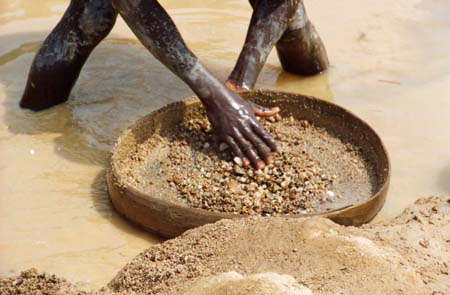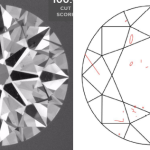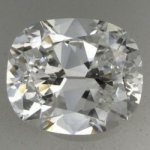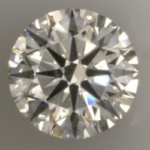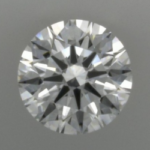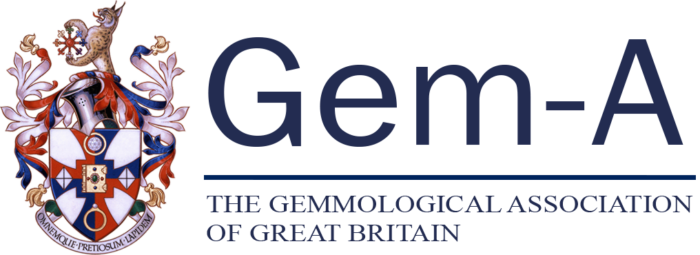Blood Diamonds, Conflict Free Diamonds, Canadian Diamonds, and Eco-Friendly Diamonds
We are all familiar with the 2006 blockbuster movie Blood Diamond, that Leonardo DiCaprio starred in. In this movie, the masses were made aware of illegal diamond sales to fund the civil wars in Sierra Leone and Liberia in the 1990’s. Do consumers still need to worry about blood diamonds? What do consumers need to know about the term ‘conflict free’? What are ‘Green Diamonds’ or ‘Eco-Friendly’ diamonds?
What Are Blood Diamonds?
Let’s first understand what ethical and non-ethical sourcing of diamonds entails. In the 1990’s there were several politically unsafe African countries where rebel groups had taken control of some of the diamond mines and were using the money made from diamond sales to fund weapons and other war operations. Rebels also stole diamonds from alluvial deposits in rivers to fund weapons for the civil war. Soon the rest of the world was made aware that these civil wars were either directly or indirectly being funded by the illegal sale of these confiscated diamonds; aka blood diamonds.
Kimberely Process Certification Scheme – KPCS
In 2002 the United Nations decided to create an international process requiring certification of all rough diamonds in order to guarantee that their trade didn’t fund rebel war activities. This process was called the Kimberley Process Certification Scheme (KPCS) or The Kimberly Process, and it basically set out rules and regulations for each participating country to abide by in order to buy rough diamonds legally and without fear of funding the civil war. Members of the KPCS are required to certify that all rough diamond exports are produced through legitimate mining and sales activities and are therefore “conflict-free.” Every shipment has a certificate that details:
-
- Where the diamonds came from
- How they were mined
- Where diamonds were cut and polished
- All parties involved in the handling of such diamonds
- Ultimate destination
Every step is regulated and accounted for with the idea that KPCS members cannot trade with non-members. In the US market, virtually all diamonds are conflict-free due to the fact that most rough is mined and manufactured (cut and polished) by about 25 different companies. According to GIA, 99% of diamonds sold today are now conflict free.
Do Consumers Still Need To Worry About Conflict Free Diamonds?
![]()
KPCS participating countries now control roughly 99.8% of the total diamond supply. Experts now say that the share of conflict diamonds fell from approximately 4% to less than 1% of the global trade. Now that we have established this fact, we have to remember that Africa is still a 3rd world nation where Botswana exports gold and South Africa is the world’s biggest producer of diamonds. As such these nations actually benefit from the now regulated and sustainable employment created by these diamond mines.
Now, more than 10 years later, the Kimberely Process is a very regulated process with continuing efforts in working towards a goal of eventually zero conflict diamonds entering the mainstream market. Much work still has to be done to satisfactorily eliminate the small percentage still participating in illegal activities. However, with the world and industry being hyper aware of the previous blood diamond history, it is extremely difficult if not impossible to operate a legitimate diamond business outside the confines of the Kimberley Diamond Act, this due to many retailers being legally required to agree to only participate with KPCS members that strictly adhere to ethical and rough diamond mining and selling.
What About ‘Canadian Diamonds’ – Should Consumers Buy Canadian Diamonds Instead?
![]()
In an effort to capitalize on consumer’s fear of inadvertently purchasing a conflict diamond, retailers have devised various marketing plans to entice consumers to purchase elsewhere. One such philosophy is the mining and purchasing of Canadian diamonds. Canadian diamonds are relatively new to the market and consumers like that it is a straightforward mining and cutting operation that is easily traced and certified without the stigma of previous civil war association.
Popular diamond retailers like Brilliant Earth are very active in this movement and tout their ethically sourced diamonds from mines located in Canada, Namibia, Botswana, South Africa, or Russia. Many consumers are specifically interested in Canadian mining sources which they deem completely conflict free. Some of the the biggest transnational mining companies in the world have mines in Canada, including: BHP-Billiton, Rio Tinto and De Beers. However, just because diamonds are not mined in conflict nations doesn’t dismiss the damage that mining activities have on the environment including wildlife, wilderness and water systems. For some, it affects the local culture and human social systems, as is the case with local Canadian tribe nations.
It must be accepted that diamond mining will never be considered a ‘Green Act’ and therefore the drilling of new open pit mines in previously undisturbed areas is a matter of ongoing concern – even in Canada. For more information on how mining actually works, take a look at the Diamond Mining Documentary below:
What About Lab-Created Diamonds – Are They Truly Eco-Friendly?
![]()
Some may argue that the only truly ethical and environmentally safe diamonds are those that are created by man himself; in a laboratory setting. Synthetic or otherwise known as lab-created diamonds, do not pollute ecosystems and destroy habitats as in the Canadian Arctic tundra or the tropical forests of Africa. In fact, Leonardo DiCaprio is a partner in the Silicon Valley startup, Diamond Foundry, most notable for creating synthetic diamonds using the Chemical Vapor Deposition or CVD process.
The CVD method requires moderate temperatures and low pressure with smaller and less expensive equipment. Over the years, CVD producers have found that by altering the gases in the growth chamber and using a purer Type II synthetic or natural diamond as a seed crystal, they can improve the color of the finished synthetic diamond and speed the growth rates. Single crystal diamond growth currently depends on the size of the single crystal seed available, and the engineering of the reactor.
Energy is one of the major costs in the CVD growth of a diamond while capital investment and labor quickly follow second. It is true that lab-created diamonds have a smaller carbon footprint and shorter chain of custody when compared to natural mined diamonds. However, any process has it’s energy expenditure and creating diamonds in a laboratory setting is no different.
The use of chemicals, namely hydrogen and methane, are still cultivated from the earth. It must be remembered that these laboratory created diamonds are also produced in factories which has primarily waste heat from the plasma and substrate, hydrogen, and any unused reactant hydrocarbon gases. To call something eco-friendly may convey that the product has no negative environmental impact; which isn’t the case with the manufacturing of lab-created diamonds. The more correct statement would be to say that lab-grown diamonds have an overall less environmental impact when compared to naturally mined diamonds.
So Where Should You Buy Your Diamond?
If you are concerned about purchasing a conflict free diamond be assured that retailers must abide by strict laws and legal requirements in sourcing their rough from only ethical and non-conflict sources. With specific concern of the African nations, as they are one of the major exporters of precious metals and diamonds, please remember that the industry provides livelihoods for millions of people around the globe. The mining, sorting, valuing, cutting, polishing, and jewelry retail and jewelry manufacturing all contribute to employment opportunities to allow thousands of Africans to make a salary, obtain healthcare, create a better home environment, and provide education for their children.
Canadian diamonds are a perfectly fine alternative if you want to source your diamond from this region, but be aware that referring to these diamonds as completely conflict free isn’t wholly true and is largely a marketing gimmic.
Lab Created diamonds or synthetic diamonds have the least environmental impact but cannot be called ‘eco-friendly’ as they still do have a detrimental affect to the environment; they simply have a less overall impact when compared to mined diamonds.
With the industrial evolution and the continuing outsourcing of manufactured goods we must understand that diamonds are just another highly valued material that can fall prey to ethical and moral issues. Education and getting informed on the origins of our goods makes us responsible for what happens to our planet and fellow human beings. Always ask where your diamond has come from and be sure to press your retailer for proof to satisfy your request. The more consumers take action on this, the more the industry will be forced to change and be accountable for their actions. If you need help in finding a conflict free and ethically sourced diamond, please don’t hesitate to contact me.
Happy Diamond Buying!
Hey.You Want Ideal Cut Diamonds?
You've got it.
Join ODBA's Diamond Deal Friday and get handpicked diamonds every week from me to you.
No consultation required. Subscribe now!
ODBA Recommends
You May Also Like

